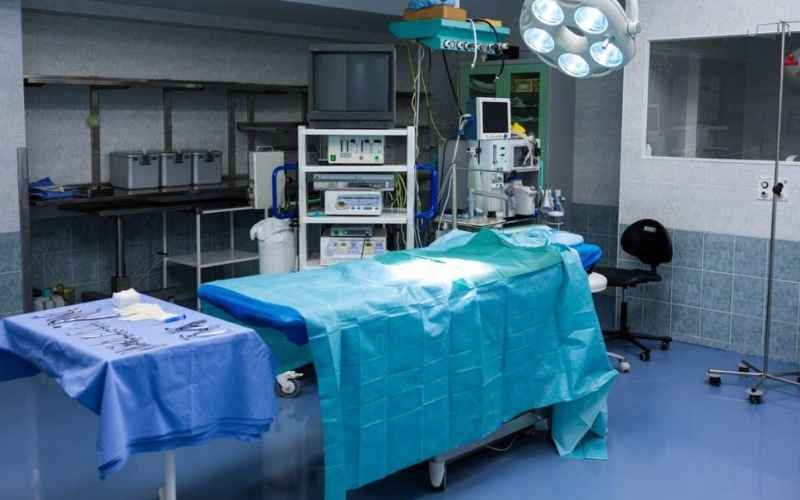Indian Government Issues Advisory for Hygiene and Safety in ICUs
In a bid to ensure the utmost hygiene and safety standards in intensive care units (ICUs), the Indian government has issued a crucial advisory directed at healthcare workers. The advisory, which prohibits the use of cellphones and jewellery within ICUs, aims to mitigate the risk of contamination and enhance patient care quality.

Directive Details
The directive specifically targets healthcare workers and mandates the following:
- Prohibition of Cellphones: Healthcare workers are instructed to refrain from using cellphones while inside ICUs. This measure aims to minimize the risk of cross-contamination by reducing the introduction of potentially harmful pathogens from external environments.
- Ban on Jewellery: The advisory also prohibits the wearing of jewellery by healthcare personnel within ICUs. Jewellery, including rings, bracelets, and necklaces, can harbor bacteria and other pathogens, posing a threat to both healthcare workers and patients.
Potential Impact on Healthcare Practices
The implementation of this directive is expected to have several notable impacts on healthcare practices within ICUs:
- Enhanced Hygiene Standards: By eliminating the use of cellphones and jewellery within ICUs, healthcare facilities can uphold higher hygiene standards. This reduction in potential sources of contamination can contribute to a safer environment for both patients and healthcare workers.
- Reduced Risk of Infection: Cellphones and jewellery serve as potential reservoirs for bacteria and viruses. By restricting their presence in ICUs, the likelihood of nosocomial infections can be significantly reduced, ultimately improving patient outcomes.
- Focused Attention on Patient Care: With healthcare workers no longer distracted by personal devices or accessories, their focus can remain squarely on providing optimal care to patients. This may lead to improved communication, quicker response times, and overall better patient experiences within ICUs.
- Compliance Challenges: While the advisory is aimed at promoting safety and hygiene, its implementation may face challenges related to compliance. Healthcare workers accustomed to using cellphones for communication or wearing jewellery as part of their attire may require time and support to adapt to these new guidelines.
Central Government Advisory: Cellphone and Jewellery Restrictions in ICUs
The advisory issued by the central government explicitly instructs government health workers to refrain from using cellphones and wearing jewellery while inside ICUs. These measures are deemed essential to minimize the transmission of pathogens and maintain a sterile environment crucial for patient recovery.
Importance of the Advisory
- Minimizing Pathogen Transmission: Cellphones, often overlooked as potential vectors for pathogens, can harbor various microorganisms due to frequent handling and exposure to different environments. By prohibiting their use within ICUs, the advisory aims to reduce the risk of cross-contamination between healthcare workers, patients, and the ICU environment.
- Sterile Environment for Patient Recovery: ICUs require a meticulously sterile environment to prevent infections and facilitate patient recovery. The inclusion of jewellery in the advisory emphasizes the importance of eliminating potential sources of contamination. Jewellery, particularly rings and bracelets, can accumulate bacteria and other pathogens, posing a threat to patients with compromised immune systems.
Addressing Prevailing Issues
- Cellphone Usage: The widespread use of cellphones among healthcare workers has been identified as a significant contributor to cross-contamination in healthcare settings. By addressing this issue in the advisory, the central government underscores the importance of mitigating potential sources of infection transmission.
- Inclusion of Jewellery: While cellphones have received considerable attention in infection control efforts, the inclusion of jewellery in the advisory highlights the need for comprehensive hygiene practices. Healthcare workers are reminded to minimize potential sources of contamination, including personal accessories that can harbor pathogens.
Promoting Meticulous Hygiene Practices
- Adherence to Guidelines: The advisory serves as a reminder to healthcare workers to adhere to strict hygiene protocols while working in ICUs. By refraining from using cellphones and wearing jewellery, healthcare personnel can contribute to maintaining a sterile environment conducive to patient recovery.
- Preventive Measures: Prohibiting the use of cellphones and jewellery in ICUs is a preventive measure aimed at reducing the risk of nosocomial infections. By implementing these measures, healthcare facilities can prioritize patient safety and minimize the transmission of pathogens within healthcare settings.
Rationale Behind the Directive: Infection Control and Patient Safety
The prohibition of cellphones and jewellery in ICUs is grounded in the principles of infection control and patient safety.
Cellphones as Vectors of Pathogens
- Pathogen Harboring: Cellphones are notorious for harboring various pathogens due to frequent handling and exposure to different environments. The surfaces of cellphones can become contaminated with bacteria, viruses, and other infectious agents, posing a significant risk of introducing these pathogens into the ICU environment.
- Cross-Contamination Risk: Healthcare workers often use cellphones during patient care activities without proper disinfection, increasing the risk of cross-contamination between patients, healthcare workers, and the ICU environment. This can potentially lead to healthcare-associated infections and compromise patient safety.
Jewellery and Compromised Hand Hygiene
- Bacterial Reservoir: Jewellery, such as rings, bracelets, and necklaces, are often worn as a form of personal adornment. However, these items can harbor bacteria and other microorganisms, especially in the intricate crevices and surfaces, creating a reservoir for pathogens.
- Hand Hygiene Compromise: Healthcare workers wearing jewellery may inadvertently compromise hand hygiene practices, as bacteria from jewellery can transfer to hands during patient care activities. Proper hand hygiene, including handwashing and use of hand sanitizers, is crucial for preventing the transmission of infectious agents in healthcare settings.
Ensuring Sterile Environment and Patient Safety
- Preventive Measure: Prohibiting the use of cellphones and wearing jewellery in ICUs is a preventive measure aimed at reducing the risk of introducing infectious agents into the ICU environment. By eliminating potential sources of contamination, healthcare facilities can maintain a sterile environment conducive to patient recovery and safety.
- Patient-Centered Approach: The directive prioritizes patient safety by minimizing the risk of healthcare-associated infections. Patients in ICUs are often vulnerable to infections due to underlying medical conditions and weakened immune systems. Therefore, strict infection control measures, including the prohibition of cellphones and jewellery, are essential for protecting patients from harm.
Challenges and Compliance in Implementation
While the advisory sets forth clear guidelines for healthcare workers, its implementation may encounter challenges related to compliance and adherence.
Breaking Ingrained Habits
- Cellphone Usage: Healthcare workers are accustomed to using cellphones for communication and accessing information, even within the confines of ICUs. Breaking away from this ingrained habit may prove challenging, especially in high-stress environments where quick communication is crucial for patient care.
- Jewellery Wearing: Similarly, the practice of wearing jewellery may be deeply ingrained in the personal habits of healthcare workers. Adjusting to the prohibition of jewellery within ICUs may require conscious effort and behavioral change.
High-Stress Environments
- Pressure of Patient Care: ICUs are high-stress environments where healthcare workers must make critical decisions and provide intensive care to patients. In such environments, the focus may naturally gravitate towards immediate patient needs, potentially leading to oversight or neglect of advisory guidelines.
- Time Constraints: Healthcare workers in ICUs often face time constraints and heavy workloads, leaving limited time for adherence to additional protocols. Incorporating the prohibition of cellphones and jewellery into an already demanding routine may present logistical challenges.
Commitment to Patient Safety
- Unwavering Commitment: Despite the challenges, healthcare professionals must demonstrate unwavering commitment and diligence in adhering to the advisory guidelines. Safeguarding patient health and preventing healthcare-associated infections should remain paramount, motivating healthcare workers to prioritize compliance.
- Education and Support: Healthcare facilities can support compliance efforts by providing comprehensive education and training on the rationale behind the advisory and the importance of adherence. Clear communication channels and supportive measures can facilitate the transition towards compliance.
Continuous Monitoring and Improvement
- Monitoring Compliance: Continuous monitoring of compliance with the advisory guidelines is essential to identify areas of improvement and address any challenges that arise. Regular audits and feedback mechanisms can help track adherence levels and provide support where needed.
- Adapting Strategies: Healthcare facilities may need to adapt strategies and interventions based on feedback and evolving circumstances. Flexibility and willingness to adjust approaches can enhance overall compliance and effectiveness of the advisory measures.
Positive Impact on Patient Care in ICUs
The enforcement of the advisory is poised to have a positive impact on patient care outcomes within ICUs.
Safer and Hygienic Environment
- Reduced Contamination Risk: By eliminating potential sources of contamination such as cellphones and jewellery, healthcare workers can create a safer and more hygienic environment within ICUs. This reduction in contamination risk lowers the likelihood of healthcare-associated infections, promoting faster patient recovery and reducing the incidence of complications.
- Enhanced Infection Control: Strict adherence to infection control measures outlined in the advisory contributes to a more effective control of infectious agents within the ICU environment. This not only protects patients from potential harm but also safeguards healthcare workers and other individuals within the healthcare facility.
Improved Healthcare Delivery
- Focused Attention on Patient Care: With distractions such as cellphones removed from the equation, healthcare workers can maintain a higher level of focus and concentration on providing quality patient care. This translates to improved monitoring, timely interventions, and better management of patient needs, ultimately leading to enhanced healthcare delivery.
- Consistent Hygiene Practices: The enforcement of the advisory reinforces the importance of consistent hygiene practices among healthcare workers. By adhering to strict hygiene protocols, including hand hygiene and minimizing potential sources of contamination, healthcare facilities can maintain a standard of care that promotes patient safety and well-being.
Building Trust and Confidence
- Patient Trust: Adherence to stringent infection control measures fosters trust between patients and healthcare providers. Patients and their families can have confidence in the healthcare facility’s commitment to maintaining a safe and hygienic environment, which positively impacts their overall experience and perception of care.
- Professionalism and Accountability: Demonstrating compliance with the advisory reflects professionalism and accountability on the part of healthcare workers. It signals a commitment to patient safety and quality care, reinforcing the trustworthiness and reliability of the healthcare team.
Conclusion:
The issuance of the advisory by the Indian government underscores its commitment to upholding the highest standards of healthcare delivery, particularly in critical care settings. By mandating the avoidance of cellphones and jewellery in ICUs, the government aims to mitigate the risk of nosocomial infections and prioritize patient safety. Moving forward, strict adherence to these guidelines is paramount to ensuring optimal healthcare outcomes and maintaining public trust in the healthcare system.
Top 20 FAQs about No Cellphone, Jewellery Use in ICU: Centre Issues Advisory for Govt Health Workers
- Why has the government issued an advisory regarding cellphone and jewellery use in ICUs?
- The advisory aims to minimize the transmission of pathogens and maintain a sterile environment crucial for patient recovery in ICUs.
- Who does the advisory apply to?
- The advisory applies to government health workers working in intensive care units (ICUs).
- What is prohibited according to the advisory?
- The advisory prohibits the use of cellphones and wearing jewellery while inside ICUs.
- Why is cellphone usage prohibited in ICUs?
- Cellphones can harbor various pathogens due to frequent handling and exposure to different environments, posing a risk of introducing infectious agents into the ICU environment.
- How can cellphones contribute to cross-contamination in healthcare settings?
- Cellphones used during patient care activities can transfer pathogens between patients, healthcare workers, and the ICU environment, increasing the risk of healthcare-associated infections.
- Why is the wearing of jewellery prohibited in ICUs?
- Jewellery, including rings, bracelets, and necklaces, can harbor bacteria and compromise hand hygiene practices among healthcare workers, increasing the risk of contamination.
- What are the potential consequences of cellphone and jewellery use in ICUs?
- Cellphone and jewellery use in ICUs can lead to healthcare-associated infections, compromise patient safety, and hinder the efficacy of infection control measures.
- Are there exceptions to the advisory?
- The advisory does not specify exceptions; however, healthcare facilities may provide guidelines for specific circumstances, such as emergency situations.
- How will healthcare workers communicate without cellphones in ICUs?
- Healthcare facilities may provide alternative communication methods, such as designated landline phones or communication devices within the ICU premises.
- Are there penalties for non-compliance with the advisory?
- The advisory may be enforced through institutional policies and disciplinary measures for non-compliance; however, specific penalties are not mentioned in the advisory.
- How can healthcare workers adapt to the prohibition of cellphones and jewellery?
- Healthcare workers can adapt by prioritizing patient care, using alternative communication methods, and practicing strict adherence to infection control protocols.
- What support will be provided to healthcare workers to comply with the advisory?
- Healthcare facilities may offer training, education, and resources to support healthcare workers in complying with the advisory and adapting to the new guidelines.
- Will there be monitoring of compliance with the advisory?
- Healthcare facilities may implement monitoring mechanisms, such as audits and feedback systems, to assess compliance with the advisory guidelines.
- How will the effectiveness of the advisory be evaluated?
- The effectiveness of the advisory may be evaluated based on indicators such as reduction in healthcare-associated infections, adherence levels among healthcare workers, and patient outcomes in ICUs.
- Is there scientific evidence supporting the prohibition of cellphones and jewellery in ICUs?
- The advisory is grounded in principles of infection control and hygiene practices supported by scientific evidence demonstrating the potential for cellphones and jewellery to harbor pathogens.
- Will there be flexibility in implementing the advisory based on individual healthcare facilities?
- Healthcare facilities may have some flexibility in implementing the advisory based on their specific needs and resources while ensuring compliance with core infection control principles.
- How can healthcare workers maintain professionalism while adhering to the advisory?
- Healthcare workers can maintain professionalism by prioritizing patient safety, following institutional guidelines, and demonstrating accountability in adhering to the advisory.
- Are there any exceptions for healthcare workers who require jewellery for religious or cultural reasons?
- The advisory does not mention exceptions for religious or cultural reasons; however, healthcare facilities may consider individual needs and provide accommodations where appropriate.
- Will visitors also be required to comply with the advisory?
- The advisory specifically targets government health workers; however, healthcare facilities may extend similar guidelines to visitors to maintain a sterile environment in ICUs.
- How can healthcare workers ensure effective communication and patient care while complying with the advisory?
- Healthcare workers can ensure effective communication and patient care by utilizing alternative communication methods, collaborating with colleagues, and maintaining a patient-centered approach in ICUs.
Related posts:
 Air Pollution Exacerbates Sleep Apnea Risk and Severity, Finds New Study
Air Pollution Exacerbates Sleep Apnea Risk and Severity, Finds New Study
 Healing Varicose Veins with Ayurvedic Therapies: A Natural Approach to Wellness
Healing Varicose Veins with Ayurvedic Therapies: A Natural Approach to Wellness
 Stretch Away the Stiffness: Combatting the Hazards of Long Sitting Hours
Stretch Away the Stiffness: Combatting the Hazards of Long Sitting Hours
 The Silent Killer: Exploring the Health Hazards of Prolonged Sitting
The Silent Killer: Exploring the Health Hazards of Prolonged Sitting
 The Deafening Truth: How Traffic Noise Raises the Risk of Cardiovascular Diseases
The Deafening Truth: How Traffic Noise Raises the Risk of Cardiovascular Diseases
 Beauty Secrets: Your Guide to Health and Beauty
Beauty Secrets: Your Guide to Health and Beauty
 Silent Threat: How Dangerous is a Silent Heart Attack?
Silent Threat: How Dangerous is a Silent Heart Attack?
 The Ultimate Guide to Romand Lip Tint: Your Perfect Pout Partner
The Ultimate Guide to Romand Lip Tint: Your Perfect Pout Partner
 Working from Home? Try These 5 Ways to Overcome a Sedentary Lifestyle
Working from Home? Try These 5 Ways to Overcome a Sedentary Lifestyle
